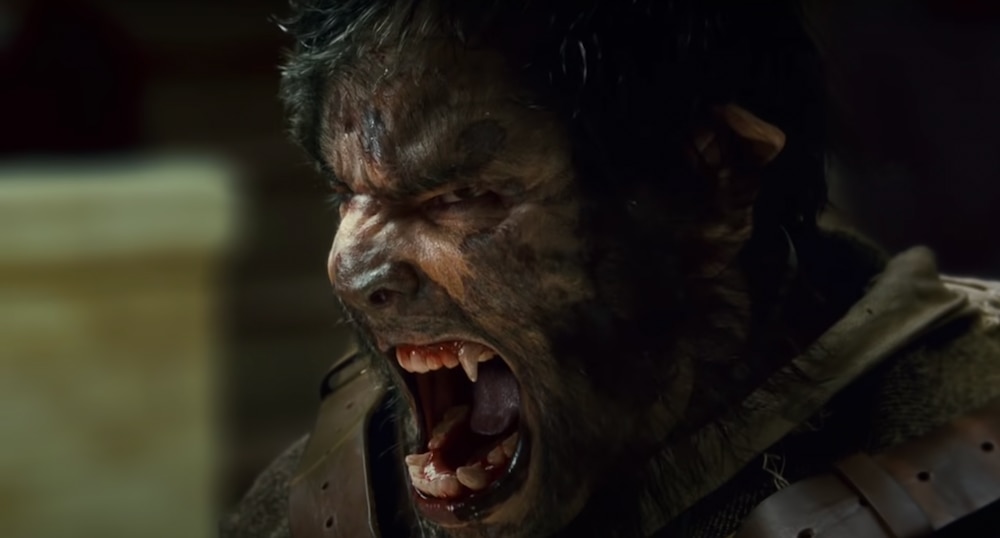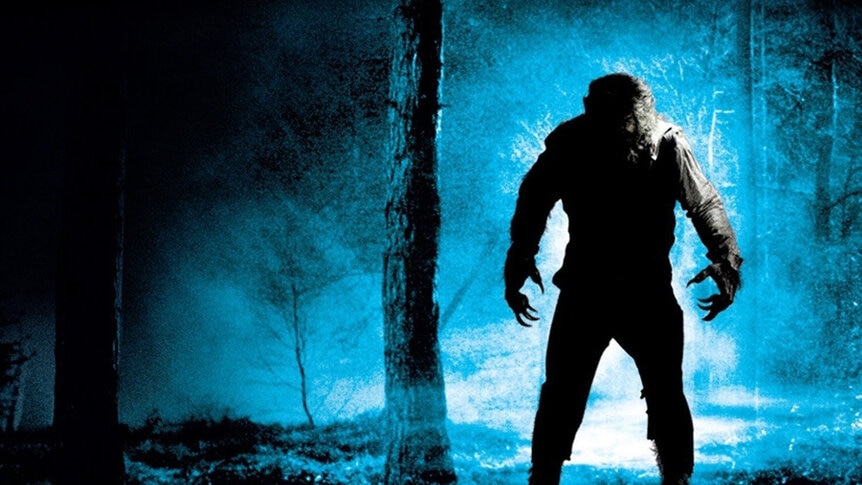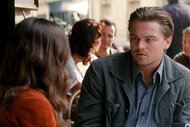Create a free profile to get unlimited access to exclusive videos, sweepstakes, and more!
Revisiting 2010's Remake of The Wolfman and That Visceral Operating Theater Transformation
The film's VFX supervisor explains how he turned Benicio del Toro into a bloodthirsty monster.

You don't need a full moon to enjoy Joe Johnston's 2010 remake of The Wolfman (streaming now on Peacock), which is certainly worth another look a little over a decade later. It's gorier, classier, and yes, even sexier than you probably remember! A Gothic horror story featuring Benicio del Toro, Anthony Hopkins, Emily Blunt, and Hugo Weaving? Come on — what's not to like?!
In particular, we'd like to draw your attention to the film's most iconic sequence, in which a restrained Lawrence Talbot (del Toro) viscerally transforms in the middle of a Victorian-era operating theater. Chatting with SYFY WIRE over Zoom, the movie's VFX Supervisor, Steven Begg, reveals that the scene was originally envisioned as a mixture of CGI and the practical makeup effects created by Rick Baker (one of Begg's cinematic "heroes" growing up) and David Elsey.
RELATED: The best horror movies on Peacock
"I assumed that what we would be blending and morphing some of his various designs during the transformation from one to another," Begg recalls. "I thought that would be the bulk of our work. On the actual day of the shoot ... I was just instructed to slap some [motion capture] dots on Benicio. [They said] ‘We want to design the transformation stuff later, not now in front of the camera.’"
He credits this last-minute change to a lack of prep time, as Johnston (Captain America: The First Avenger), who boarded the project shortly after the film's original director, Mark Romanek (One Hour Photo), exited due to creative differences. Despite this unexpected development behind the camera, Begg remains happy with the end result. "I'm pleasantly surprised and pleased by what we got," he declares. "It's kind of like, 'What would a wolf look like bursting out of a human skin? What would that look like for real?’"
The evolution of 2010's The Wolfman movie
Begg characterizes Romanek's initial vision for the movie as "a very cerebral werewolf film." Johnston carried the general idea forward, hoping to achieve "really dark, foreboding imagery. I think, if anything, that's given the film a longevity that it probably wouldn't have had if it had been just a classic, crash-bang-wallop period horror film."
Of course, the thing that cast the largest shadow over the production was Baker's stunning work on An American Werewolf in London, the quintessential werewolf transformation of the entire lupine sub-genre. "The main thing was trying not to look like any other transformation that had been done before," Begg continues. "We watched everything that had been done before to try and not repeat stuff too closely."
Begg's most significant contribution to the sequence is also its most memorable: the visual of Talbot's fingers extending and dislocating (the studio liked this so much, in fact, that they made it one of the big selling points in the official trailer). "I was trying to imply that the skeletal structure was becoming gelatinous and reforming into a different shape," Begg explains. "It was a great deal of work and a CGI transformation at that level and scrutiny had not been done before. We worked really hard on that and did multiple iterations before Joe was happy with it."
The VFX supervisor goes on to credit del Toro for selling the painful nature of the metamorphosis via his physical performance: "He actually contorts and bends his body and face into really grotesque and frightening shapes. This is before we applied the CGI stuff on top of him. So he drove all of that … Just out of view, we had other cameras and they're used as reference to drive the CG object that's going to be underneath that, so all of those twitches and [emulates monster noises], that’s 100 percent Benicio."
Check out the full transformation clip below:
The scene ends with a splash of dark comedy as Dr. Hoenneger (Anthony Sher) — the cruel and Freudian psychiatrist who refuses to believe Talbot's warnings — is picked up by the monster and unceremoniously thrown out of a window before falling to his death on a spiked gate below. It's a heaping plate of karmic irony for Hoenneger, who, just moments before tells Lawrence: "You were not bitten by a werewolf. You will not become a werewolf, any more than I will sprout wings and fly out of that window."
"That's all real [when] he picks the actor up initially and then it’s a stunt guy going through the window on a wire. The flight is CGI, but the landing is not," Begg reveals. "It’s actually a double and he's been dropped 2-3 feet onto fake railings without the spikes, obviously — they were added later — thunking onto the top and then writhing a bit. Then we added them coming out of his back. I thought that was a slightly comical, but incredibly brutal moment. I think that encapsulates the whole movie as well because you've got these scudding clouds and a full moon [in the sky]. There’s a slight comic book feel about it."
The creature's ensuing rampage through the streets and rooftops of late 19th century London utilized an estimated "90 percent costume prosthetics," save for a number of wide shots where the VFX team needed to "replace human legs with dog legs," Begg says. "There were also the occasional shots where we really distorted the jaws and the mouth to be inhumanly bigger than you could do, even with someone in prosthetics. One of the biggest problems I had was him running on all fours. I remember fighting that greatly. I think they're the shots that pull down the quality of the effects work a little bit because it's just unbelievable, watching a humanoid shape running on all fours. It primarily started as a stuntman on a wire scrambling along, and then ultimately was replaced entirely with CGI."
That small criticism aside, everyone — Baker included — couldn't deny the impressiveness of the digital effects. "I got a note from Rick saying he was really impressed with it and he was very happy with it. To me, that’s the ultimate compliment when you get it from someone like him."
Rainy nights filming The Wolfman
An on-location shoot in the United Kingdom sealed the genre deal, with misty moors, dreary forests, cobwebbed manor houses, seedy taverns, and almost perpetual rainfall underscoring a tangible Gothic atmosphere. "I can tell you it was a very miserable shoot, weather-wise and environment-wise," Begg remembers of principal photography. "Hey, it’s a werewolf film, so you’re going to be shooting mostly at night. We spent a lot of time in the rain — either real or artificial — in forests, in mud, and all sorts of crap. It actually got quite depressing after a while, actually having to, basically like a werewolf, come to life at night to actually make the bloomin’ thing."
Nevertheless, every single element of the movie — Begg's VFX; Shelley Johnson's cinematography; Rick Heinrichs' production design; Milena Canonero's costume design; and Baker and Elsey's makeup effects — came together to make "a very lush movie," Begg says. "It’s got a lot of detail, a lot of textures. I think it's finely crafted."
The Wolfman clawed its way into theaters everywhere on Feb. 12, 2010, followed by a parade of tepid reviews that may have hindered its box office performance. In fact, the project ended up as a massive financial dud, bringing in just over $139 million worldwide against a staggering production budget of $150 million. Begg postulates that the negative reaction may have stemmed from the release of James Cameron's game-changing Avatar the year before, which ushered in the short-lived RealD 3D revolution.
"Everyone was after a completely different feel and weren’t particularly into the Gothic darkness [our] film has," he says, later adding: "It was downbeat and I don't think people wanted that at the time. It was kind of forgotten, but it's resurfaced with people looking at it and going, ‘This ain’t that bad' or ‘This is actually better than other films of similar subjects.’ It’s classy as well, it’s not a trashy film at all. It's nice to hear people are appreciating it now."
In the summer of 2020, Universal and Blumhouse announced their intentions to reboot The Wolfman property after the success of Leigh Whannell's The Invisible Man. In fact, Whannell was originally tapped to direct, with Ryan Gosling set to star as the titular beastie. Derek Cianfrance — who previously worked with Gosling on The Place Beyond the Pines — replaced Whannell as director last fall, though there haven't been any updates on the film since then. While Begg doesn't have any insider knowledge of the reboot, he'd love the opportunity to work on it. "I know the Universal execs [involved with] visual effects," he concludes. "I might drop them a line..."
The Wolfman is now streaming on Peacock.



























